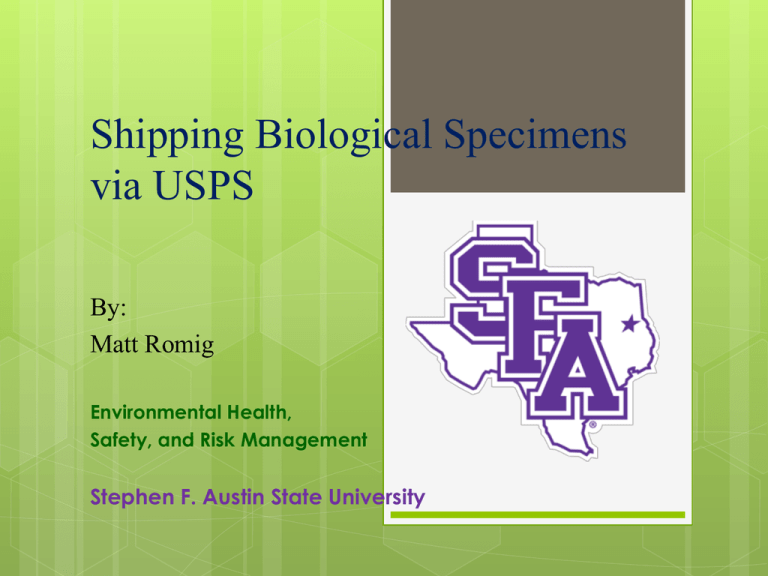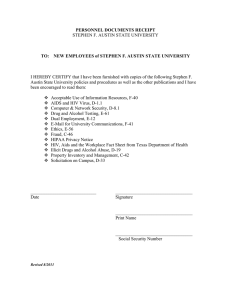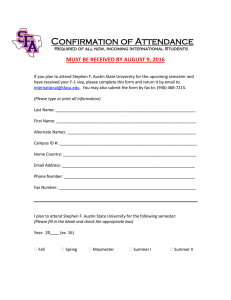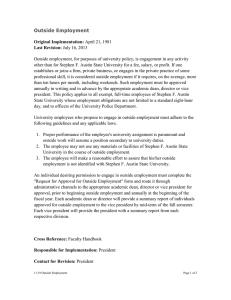Shipping Biological Specimens via USPS By: Matt Romig
advertisement

Shipping Biological Specimens via USPS By: Matt Romig Environmental Health, Safety, and Risk Management Stephen F. Austin State University Publication 52 - Hazardous, Restricted, and Perishable Mail Revised in June 2011 Environmental Health, Safety, and Risk Management Stephen F. Austin State University Hazard Classes Listed in Appendix C of publication 52 which can be found on USPS website or google. 9 different class types and one additional category. Hazard Class 6: Toxic Substances and Infectious Substances. Specifically 6C which is category B infectious substances. Environmental Health, Safety, and Risk Management Stephen F. Austin State University Hazard Classes Class 6 has two divisions: 6.1 & 6.2 6.1 includes toxic substances, poisons and irritating material. Ex: methyl bromide and tear gas 6.2 includes infectious substances. Ex: biological products, regulated medical waste, sharps medical waste, used health care products, and forensic materials. Environmental Health, Safety, and Risk Management Stephen F. Austin State University Division 6.2, Infectious Substances Definition: Infectious substance means a material known or reasonably expected to contain a pathogen. Pathogen is a microorganism that can cause disease in humans or animals. Ex: bacteria, fungi, and other infectious agents Environmental Health, Safety, and Risk Management Stephen F. Austin State University Division 6.2, Infectious Substances Category A: Infectious substance transported in form capable of causing permanent disability or life threatening or fatal disease in otherwise healthy humans or animals when exposure occurs. Category A are nonmailable and are assigned identification numbers UN2814 or UN2900 Environmental Health, Safety, and Risk Management Stephen F. Austin State University Division 6.2, Infectious Substances Category B: Infectious substance that does not meet the criteria for inclusion in category A. Mail piece known or suspected to contain a category B infectious substance must bear the proper shipping name “Biological Substance, Category B” on the address side of the mail piece. Environmental Health, Safety, and Risk Management Stephen F. Austin State University Division 6.2, Infectious Substances Apart from bearing the proper shipping name it must also be assigned to and marked with identification number UN3373. Environmental Health, Safety, and Risk Management Stephen F. Austin State University Category B: Examples Biological products like virus, therapeutic serum, toxin, antitoxin, vaccine, blood, blood component or derivate, allergenic product Cultures are infectious substances that result from a process by which pathogens are intentionally propagated and this definition does not include human or animal patient specimen. Exempt human or animal specimen means a human or animal sample transported for routine testing not related to the diagnosis of an infectious disease. Ex: secreta, blood, tissue, tissue fluids etc. Environmental Health, Safety, and Risk Management Stephen F. Austin State University Category B: Examples Patient specimen which is collected directly from humans or animals and transported for purposes such as diagnosis and research. Regulated medical waste includes soft medical waste (not sharps) derived from medical treatment, research, immunization etc. Sharps medical waste – UN3291 Toxin – Division 6.1 material from plant, animal or bacterial source. Toxin with infectious substance must be classed under division 6.2 and assigned to UN2814, UN2900 or UN3373, as appropriate. Environmental Health, Safety, and Risk Management Stephen F. Austin State University Mailability International prohibited for 6.1 but domestic mail is permitted as long as it can qualify as an ORM-D (other regulated material) and when packaged under the applicable requirements in Appendix C of USPS publication 52. Category A of division 6.2 materials are nonmailable for international shipments. International shipment is permitted for Category B only when sent as registered First-Class Mail International, Express Mail International or Global Express Guaranteed service when intended for medical, veterinary, research, or laboratory certification related to public health. Materials should be properly prepared for mailing and mailer must receive written approval from the office of Environmental Health, Safety, and Risk Management Mailing standards. Stephen F. Austin State University Mailability Domestic Mail: Infectious substances are permitted only when they are intended for medical or veterinary use, research or laboratory certification related to public health, and when properly prepared for mailing to withstand shocks, pressure changes, and other conditions incident to ordinary handling in transit Environmental Health, Safety, and Risk Management Stephen F. Austin State University Mailability: Category B of 6.2 DMM Reference 601.10.7.4 Postal Explorer > Publication 52 - Hazardous, Restricted, and Perishable Mail > Appendix C > USPS Packaging Instruction 6C > DMM Reference 601.10.7.4 Proper Shipping Name and ID Number Biological substance, Category B, UN3373. International mailing: Same as described before International shipment is permitted for Category B only when sent as registered First-Class Mail International, Express Mail International or Global Express Guaranteed service when intended for medical, veterinary, research, or laboratory certification related to public health. Materials should be properly prepared for mailing and mailer must receive written approval from the office of Mailing standards Environmental Health, Safety, and Risk Management Stephen F. Austin State University Mailability: Category B of 6.2 Category B infectious substances via First-Class Mail, Priority Mail, or Express Mail service. Basic eligibility criteria same as described before for all division 6.2 infectious substances. Required Packaging Must be triple-packaged, meeting the packaging requirements in 49 CFR 173.199, and surrounded by absorbent material sufficient to protect the primary receptacle and absorb the total amount of liquid should the primary receptacle leak or break. Environmental Health, Safety, and Risk Management Stephen F. Austin State University Mailability: Category B of 6.2 A Category B infectious substance must be packaged in a triple packaging consisting of a primary receptacle, a secondary packaging, and a rigid outer packaging. Primary Receptacle: Primary receptacles must be packed in secondary packaging in such a way that, under normal conditions of transport, they cannot break, be punctured, or leak their contents into the secondary packaging. Each primary receptacle containing a liquid must be leak proof. Each primary receptacle containing a solid must be siftproof. Environmental Health, Safety, and Risk Management Stephen F. Austin State University Primary Receptacle: Continued….. A single primary receptacle must not contain more than 1 liter (34 ounces) of a liquid specimen or 4 kg (8.8 pounds) of a solid specimen. Two or more primary receptacles whose combined volume does not exceed 4 liters (1 gallon) for liquids or 4 kg (8.8 pounds) for solids may be enclosed in a single secondary container. Environmental Health, Safety, and Risk Management Stephen F. Austin State University Cushioning and Absorbent Material The space between the primary receptacle(s) and the secondary container at the top, bottom, and sides must contain enough material to absorb the entire contents of the primary receptacle(s) in case of breakage or leakage. Either the primary receptacle or the secondary container must be capable of withstanding, without leakage, an internal pressure that produces a pressure differential of not less than 0.95 bar, 14 psi (95 kPa), and temperatures in the range of –40° F to 131° F (– 40° C to 55° C). Environmental Health, Safety, and Risk Management Stephen F. Austin State University Inner Packagings A packaging containing inner packagings of Category B infectious substances may not contain other hazardous materials except: Refrigerants, such as dry ice or liquid nitrogen, as authorized under paragraph (d) of 40 CFR 173.99 Anticoagulants used to stabilize blood or plasma; or Small quantities of Class 3, Class 8, Class 9, or other materials in Packing Groups II and III used to stabilize or prevent degradation of the sample, provided the quantity of such materials does not exceed 30 mL (1 ounce) or 30 g (1 ounce) in each inner packaging. Such preservatives are not subject to the requirements of the subchapter in 40 CFR 173.99 Environmental Health, Safety, and Risk Management Stephen F. Austin State University Refrigerated or frozen specimens Ice or dry ice must be placed outside the secondary packaging or in an overpack. Interior supports must be provided to secure the secondary packagings in the original position after the ice or dry ice has dissipated. If ice is used, the outside packaging must be leak proof or must have a leak proof liner. If dry ice is used, the outside packaging must permit the release of carbon dioxide gas and otherwise meet the provisions in 173.217. Environmental Health, Safety, and Risk Management Stephen F. Austin State University Refrigerated or frozen specimens The primary receptacle and secondary packaging must maintain their integrity at the temperature of the refrigerant used, as well as the temperatures and pressures of transport by aircraft they could be subjected to if refrigeration were lost, and sufficient absorbent material must be provided to absorb all liquid, including melted ice. The package should be marked Carbon dioxide, solid or Dry ice and an indication that the material being refrigerated is used for diagnostic treatment purposes (e.g., frozen medical specimens) or whatever the purpose related to shipping. Environmental Health, Safety, and Risk Management Stephen F. Austin State University Secondary Packaging Secondary packaging's must be secured in rigid outer packaging's with suitable cushioning material such that any leakage of the contents will not impair the protective properties of the cushioning material or the outer packaging. Secondary containers for liquids must be leak proof. Secondary containers for solids must be siftproof. The secondary packaging must be constructed of a durable material and have a secure sealing method. If the primary receptacle does not meet the pressure requirements listed before, then the secondary container must be designed to meet those requirements. Environmental Health, Safety, and Risk Management Stephen F. Austin State University Secondary Packaging: Continued… The secondary container must be marked with the international biohazard symbol shown below: Environmental Health, Safety, and Risk Management Stephen F. Austin State University Outer shipping container The address side of the outer shipping container must be marked with the proper shipping name “Biological Substance, Category B” and UN3373. The address side of the outer shipping container must be marked with the name and telephone number of a person who is knowledgeable about the material shipped and has comprehensive emergency response and incident mitigation information, or someone who has immediate access to the person with such knowledge and information. Environmental Health, Safety, and Risk Management Stephen F. Austin State University Outer shipping container: continued… The primary and secondary packaging must be enclosed in a rigid outer shipping container. The primary receptacle(s) and the secondary container must be enclosed in a strong outer packaging constructed of fiberboard or other equivalent material. At least one surface of the outer shipping container must have a minimum dimension of 3.9 inches by 3.9 inches (100 mm by 100 mm) as required by 49 CFR 173.199. The completed package must be designed, constructed, maintained, filled, its contents limited, and closed so that under conditions normally encountered in transportation, including removal from a pallet or overpack for subsequent handling, there will be no release of hazardous material into the environment. Environmental Health, Safety, and Risk Management Stephen F. Austin State University International Mail Substances identified in IMM 135.11b must be sent only by authorized laboratories to their foreign counterparts in those countries that have indicated a willingness to accept them. Countries distinguish between infectious and noninfectious (non-regulated) biological substances and may prohibit one or the other or both. See “Prohibitions” in the Individual Country Listings on USPS website or the respective country postal and customs websites. Environmental Health, Safety, and Risk Management Stephen F. Austin State University Infectious biological substances can be sent to or received by only the following types of institutions: Laboratories of local, state, and federal government agencies. Laboratories of federally licensed manufacturers of biological products derived from bacteria and viruses. Laboratories affiliated with or operated by hospitals, universities, research facilities, and other teaching institutions. Private laboratories licensed, certified, recognized, or approved by a public authority. Environmental Health, Safety, and Risk Management Stephen F. Austin State University QUESTIONS? Thank You Environmental Health, Safety, and Risk Management Stephen F. Austin State University


